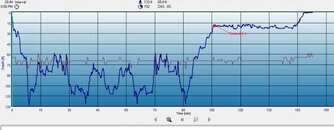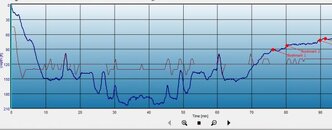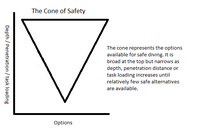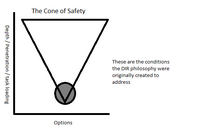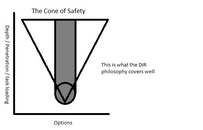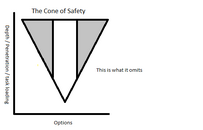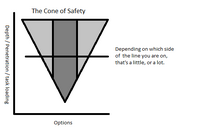You are using an out of date browser. It may not display this or other websites correctly.
You should upgrade or use an alternative browser.
You should upgrade or use an alternative browser.
Why the Compass on the Left Arm?
- Thread starter Vegan Shark
- Start date
Please register or login
Welcome to ScubaBoard, the world's largest scuba diving community. Registration is not required to read the forums, but we encourage you to join. Joining has its benefits and enables you to participate in the discussions.
Benefits of registering include
- Ability to post and comment on topics and discussions.
- A Free photo gallery to share your dive photos with the world.
- You can make this box go away
PfcAJ
Contributor
While we're at it

and

The trick is to pay attention to how long you're at each depth and avg it out. Deco accordingly. I know its becoming cliche around here, but its all taught in class.

and

The trick is to pay attention to how long you're at each depth and avg it out. Deco accordingly. I know its becoming cliche around here, but its all taught in class.
lv2dive
Formerly known as KatePNAtl
I don't think that it's cliche, past a certain point, there is only so much information that can be conveyed through a keyboard.
...I know its becoming cliche around here, but its all taught in class.
Vegan Shark
Contributor
Now I believe that part of the reason why GUE doesn't want their divers using computers is because they want them to get in the habit of considering all those things I just mentioned ... and factor them into their dive profiles.
Maybe it's in the class, but nowhere in the textbook or other information does it talk about factoring these variables into the table calculations. What would the formula even be for that? Seems more like an intuitive thing. Plus, taking into account your own physical fitness level, activity, etc. can be done with a computer as well as tables, so it's not a table-specific thing. If one blindly follows tables they can ignore those factors just as easily as someone blindly following a computer. So in that case it isn't computer vs tables that is relevant, just whether or not the diver is taking into account their personal state.
---------- Post added March 6th, 2014 at 05:45 PM ----------
it can be done quite easily and they teach you how and why in the classes
Right, but I'm not saying it can't be done, I'm asking how it's the superior choice over a computer. "It's not difficult," is an argument for why it's not too big of a deal once you're used to it, it's not an argument for why that is the standard over other options in the first place.
PfcAJ
Contributor
I'm not gunna do what a computer says anyway. I'm going to stop in different places and for different times. By not having a computer, your pretty much forced to pay attention to depth and time. There are no surprises. Computers tend to breed divers that don't pay attention, don't plan, and aren't prepared for a dive without a computer. It doesn't provide real benefit (obviously if you look at the above profiles) and the stop times and depths are so different that it's downright pointless to even have one. So why bother?
Goat_Tower
Registered
Maybe this will interest you or clear some things up: BAUE Newsletters. Though it's part of the fundies book, so you should have already read it once.Right, but I'm not saying it can't be done, I'm asking how it's the superior choice over a computer.
Vegan Shark
Contributor
Yeah, I've already read that, but it feels very outdated, and like JJ just had bad experiences using a ****ty computer sometime in the past. Many of the arguments don't apply to the latest generation of dive computers.
DaleC
Contributor
I find that to be some wearisome reasoning myself. If you can cope with technology above the surface it should not be that problematic below the surface. Why not just say, in our style of diving, at the tech level, we don't use that tool (because there it is not a safe practice) and, because we believe in continuity, we don't use it at the rec level either.. without stretching credulity by inventing reasons.
This is the big disconnect that rec divers feel when viewing dir. They see that rec diving can be done safely, differently, so the rigid stance doesn't make sense... unless you understand the philosophy of beginning with the end in mind and the continuity that it creates. Other choices at the rec level, while perfectly sound in themselves, don't "fit" further down the spectrum so they are not adopted. It really is as easy as that. If you get it, you'll get almost all the decisions revolving around the system.
The problem with that BAUE list is that 99% of rec divers today are using computers relatively safely so that, without the real reasoning explained, the reader is drawn towards two conclusions:
1.) dir divers are too inept to safely use what most other people use.
2.) Someone is making far fetched stuff up to justify a position.
I personally appreciate the singleness of purpose that dir adopts in the sense of maintaining focus on the primary goal of the system: Creating a seamless group of divers that can interact and move from one end of the spectrum to the other. Anything that takes away from that concept is put aside for the greater good; the whole is more valuable than the sum of its parts. I think that is good enough to use as justification without painting those parts as wrong.
This is the big disconnect that rec divers feel when viewing dir. They see that rec diving can be done safely, differently, so the rigid stance doesn't make sense... unless you understand the philosophy of beginning with the end in mind and the continuity that it creates. Other choices at the rec level, while perfectly sound in themselves, don't "fit" further down the spectrum so they are not adopted. It really is as easy as that. If you get it, you'll get almost all the decisions revolving around the system.
The problem with that BAUE list is that 99% of rec divers today are using computers relatively safely so that, without the real reasoning explained, the reader is drawn towards two conclusions:
1.) dir divers are too inept to safely use what most other people use.
2.) Someone is making far fetched stuff up to justify a position.
I personally appreciate the singleness of purpose that dir adopts in the sense of maintaining focus on the primary goal of the system: Creating a seamless group of divers that can interact and move from one end of the spectrum to the other. Anything that takes away from that concept is put aside for the greater good; the whole is more valuable than the sum of its parts. I think that is good enough to use as justification without painting those parts as wrong.
Vegan Shark
Contributor
Great point, Dale. I understand most of the DIR practices for their original applications in tech and cave diving. It's when they get carried over to rec diving that I get a headache trying to justify things. Simply giving the explanation of continuity and standardization would save a lot of face. Arguments like, "well, these darned things might stop working all of a sudden, and there's blinking lights, and it's all just too confusing!" just sounds like a grandma flustered after receiving an iPad for Christmas 
DaleC
Contributor
Similar threads
- Replies
- 3
- Views
- 1,066
- Replies
- 11
- Views
- 1,248
- Sticky
- Replies
- 5
- Views
- 1,931



